Mainstream Media: Touring a Peat Bog
A couple months ago, I attended an International Society of Horticulture Science conference in Quebec City, Canada. The specific conference I attended was focused on soilless substrates—what more could you want?
This specific conference is for a relatively small group of substrate scientists across the world who gather every other year to discuss current research and innovations, develop future ideas and plan collaborative work. As always, the conference was a blast and I had a great time. This year, we had a unique treat, as a small group of U.S. scientists were invited by Berger to tour the peat bogs! As a substrate scientist, this has been a dream of mine for quite some time and I was not disappointed to say the least.
 While it might not look at much, this was one of my favorite destination field trips.
While it might not look at much, this was one of my favorite destination field trips.
We toured fields that were currently in production, decommissioned fields that were actively being restored and—one of my favorite experiences—an undisturbed peat bog. I had always been told that the ground in peat bogs is “spongy” but until I was able to walk on one, I never realized what that meant. It is somewhat like what I would expect walking on the moon to be like, as you spring up and down.
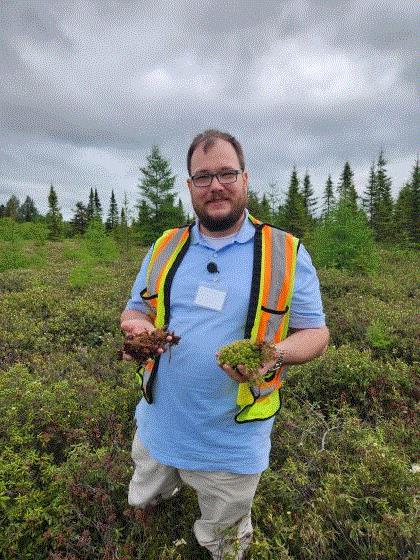
The bogs are covered with brush that includes a whole variety of vegetation in addition to the Sphagnum peat moss that is growing beneath the brush canopy.
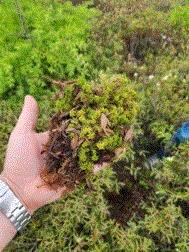
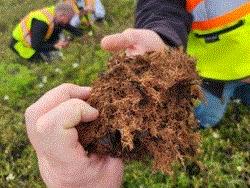
Only the upper most layer of Sphagnum moss is living. You can see the moss starting to decompose less than an inch deep.
In its natural state, there are plants growing in peat—unlike many of our other substrate materials. It’s a neat fact that I never really sat and thought about before visiting the bogs. This particular bog had quite a bit of wild blueberry growing. It is fun to think about containerized blueberries that might be growing in peat substrates, when those peat substrates may have naturally been growing blueberries all along.
Much like a beach vacation, students had a great time playing in the ... peat.
Peat harvest only occurs when the weather cooperates. Recent rains prevented us from seeing the harvest in action, but that means I have a reason to come back sometime. Typically, peat is harvested by “sucking” the top layer, just like a vacuum. Each pass can take a couple of inches off the surface.
Top: Peat moss is harvested through these large "vacuums." Bottom: Peat moss in bogs can be over 15 ft. deep.
After harvest, the peat is nearly ready for production, with little processing required after removal. The peat is stored in windrows and covered to prevent loss of moisture and peat. It is a suprisingly straightforward process, unlike much of our other media, which needs intense processing before it can be used as a growing media.
Who else takes selfies in front of substrate piles?

Mainstream Media Cont.
Beyond production, I thoroughly enjoyed learning how bogs are restored. There are different techniques, but one that I found intriguing involves lifting the top active growing layer and harvesting peat below, then placing that layer back to continue growing.
Restoration in action. This is a decommissioned bog that is being actively restored. A nice boardwalk takes you on a tour through the journey.
We also got to see perlite being “popped,” which was exciting as well. I have taught the concept of perlite manufacturing many times, but seeing the red-hot perlite rocks pop out of the furnace in the form we know as perlite, was truly exciting.
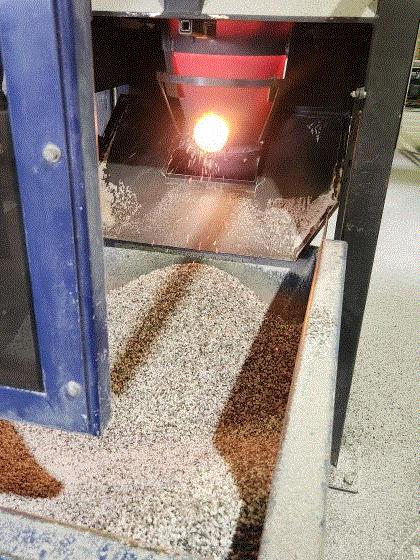 Perlite is expanded through very high heat. The individual particles are red-hot when they emerge!
Perlite is expanded through very high heat. The individual particles are red-hot when they emerge!
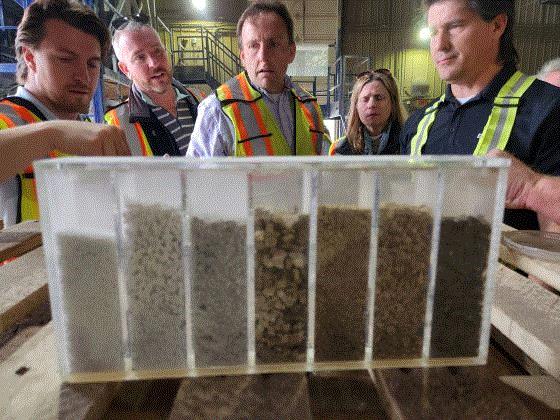
The North American substrates braintrust are enthralled with aggregate particle size!
I want to thank Berger, and especially Pierre Marc de Champlain, for their generosity and willingness to let a bunch of substrate nerds tromp through the bogs and bother them with relentless questions all day.
We had an excellent field trip to Berger. Thank you to everyone involved.

Nominations Open for the Great American Gardener Awards
Nominations are now being accepted for the American Horticultural Society’s 2024
Great American Gardeners Awards. Every year, the AHS celebrates outstanding achievements, encourages excellence, and inspires innovation in the art and science of horticulture through its Great American Gardeners Awards program.
Six categories of awards will be recognized in 2024. Nominations will be accepted through September 29, 2023. Nomination form available
here.
Liberty Hyde Bailey Award: Given to an individual who has made significant lifetime contributions to at least three of the following horticultural fields: teaching, research, communications, plant exploration, administration, art, business and leadership.
Emerging Horticultural Professional Award: Given in the early stages of an individual’s career, this award recognizes significant achievements and/or leadership that have advanced the field of horticulture in America.
Garden Stewardship Award: Given to a public garden that embraces and exemplifies sustainable horticultural practices in design, maintenance, and/or programs.
Horticultural Innovation Award: Given to an individual or company whose innovations have made the field of horticulture more sustainable and accessible to all.
H. Marc Cathey Award: Recognizes outstanding scientific research that has enriched the field of horticulture.
Jane L. Taylor Award: Given to an individual, organization or program that has inspired and nurtured future horticulturists through efforts in children’s and youth gardening.

Nursery Breeding - Upcoming Releases
Nursery crop production has always been my primary focus. I am a trained substrate scientist and work with growers in all aspects of production through my research and extension programs. However, as the Director of the Hammond Trial Gardens, I have had the opportunity to monitor breeding trends in nursery crops first-hand for a while now.
At my recent Field Day and Garden Open House, I spoke briefly about the current trends we are witnessing, particularly regarding breeding woody shrubs for compactness. I expect this is likely a response to smaller footprints and landscapes across the country, but that is just my guess.
With my interest in new releases, and an almost non-existent knowledge of how plant breeding actually works, I enjoyed reading about the concept of gene stacking by an author you may all know very well (one Dr. Matthew Chappell) in the August issue of GrowerTalks magazine. The concept makes sense once explained, and also gives insight into how our breeders are doing such a good job at pumping out awesome new varieties on a regular basis.
I would highly recommend
his article on the concept and some of the new shrub introductions hitting availability soon. I expect to have a few discussions about current and future trends around woody breeding over the coming months. Hopefully, we can all learn more about these new (at least new to me) concepts that keep our coffers full each season.

Nursery Automation Webinar
When I talk with growers and ask what they need help with, I secretly always hope they say, “Well Jeb, I really need some input on our growing media,” or “We want to develop a new substrate blend to improve our water efficiency.” While that does happen, inevitably, the first topic discussed is labor. Typically, the lack of available labor is the prime discussion point. While I am no labor expert, one idea that I think we as an industry are starting to turn towards is automation. Mechanizing repetitive tasks in production seems to be gaining momentum across the country and might just help alleviate some of the labor concerns by expanding the capacity of each worker.
Luckily, Dr. Amy Fulcher of University of Tennessee has been working on this concept for a while now. Dr. Fulcher is providing a webinar through AmericanHort starting at 2 p.m. on August 29, to discuss opportunities to automate in the nursery. If you are at all interested in automation and mechanization, I expect you will not regret this hour-long session where you can learn tips for investing in automation, affordable first steps, common barriers to adoption and more.
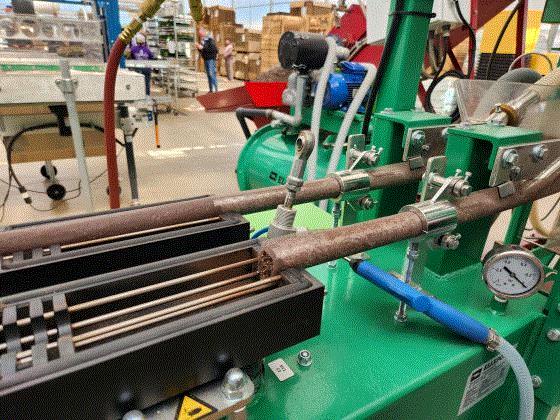
Most standardized processes can be mechanized.
Make sure you register and mark your calendars, because this live webinar is not being recorded. You can find out more about this session and register by
clicking this link.

The Landscape Show
There is still more trade show fun to be had this summer. We have discussed Farwest trade show coming up in a couple weeks for growers on the West Coast. For folks on the East Coast (or anywhere for that matter), the 2023 Landscape Show will be held in Orlando, Florida on August 23-25.
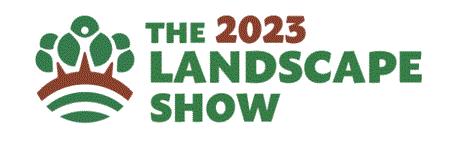
The Florida Nursery and Landscape Growers Association (FNGLA) hosts this show each year, which has more than 700 vendors and booths and the Knowledge College, an impactful two-day educational lineup, making the Landscape Show one of the top trade shows in the country. Make sure you check it out, especially if you can’t get to Farwest this year.
Three Woody Plants Win the Coveted Retailers’ Choice Award
Cultivate’23 wrapped up a couple weeks ago, but the excitement continues. The Garden Center Group announced 15 winners for the 2023 Retailers’ Choice Awards. This year’s winners include three woodies that are sure to impress.
First up is Hydrangea Eclipse from Bailey Nurseries—First Editions. This new addition to the First Editions family is a hydrangea that features dark purple foliage and cranberry blooms. Eclipse holds the dark color well, even after being cut back and in warmer climates.
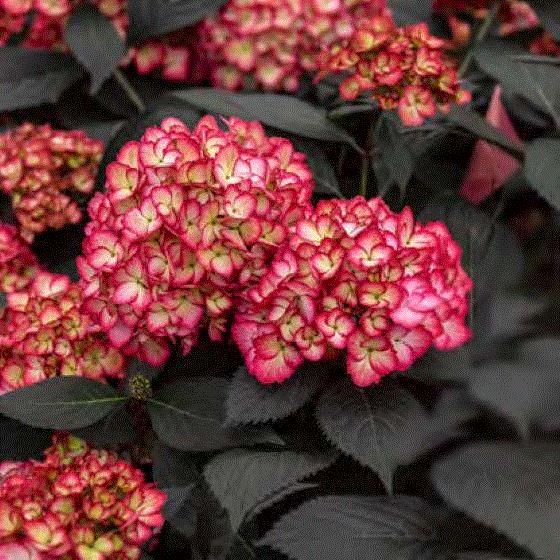
Hydrangeas are popular this year, as the next winner is the new red reblooming hydrangea Cherry-Go-Round from Bloomin’ Easy. This heavy rebloomer offers eye-catching cherry red flowers that deepen in the shade as they mature.

Finally, it seems reds are hot this year. The third award winner I’m mentioning from this list is Garden Gems Amethyst Redbud from Star Roses and Plants. Judges mentioned that this Cercis has some of the deepest purple color, which is expected to hold throughout the heat of summer.


Danziger Announces Imagine More Scholarship Program
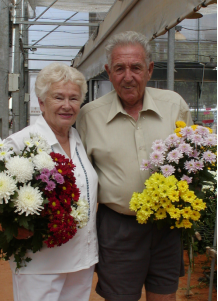
Danziger is celebrating its 70th anniversary by focusing on the future. To mark this milestone, the company is partnering with the Horticulture Research Institute to develop a new scholarship. The Danziger Imagine More Scholarship Fund is the latest investment in the future of the industry.
“We are very proud of the past 70 years and our growth from a small family farm to one of the leading floriculture companies,” said Ori Danziger, deputy CEO. “We are blessed to be a part of this beautiful industry, to create innovative new varieties and to have the best customers and partners to grow with. Today is about recognizing the blessings of our history. I can’t think of a better way to honor my grandparents—the founders of our company—Ernest and Zehava Danziger—than by supporting the future of our industry. They will both celebrate their 100th birthday soon and we wish them many, many more happy and healthy years.”
Throughout its history, Danziger has always placed a high value on innovation and the power of imagination. “Supporting young students has been a core value for us,” Ori said. “We have given away more than 200 academic scholarships in Israel. This year we’ve decided to extend our scholarship program to horticulture students in the U.S. We believe that welcoming a new generation with creativity and passion into the business will keep supporting our industry’s growth.
The Danziger Imagine More Scholarship Fund will provide assistance to help horticulture students reach their full potential.




Think big,

Jeb Fields
Editor-at-Large
Nursery & Landscape Insider
This has been received by 32,182 of the hardest-working horticulturists in show business!
If you're interested in reaching 32,182 clients who eagerly await every Nursery & Landscape Insider and surely read every word, contact Kim Brown ASAP and she'll hook you up.